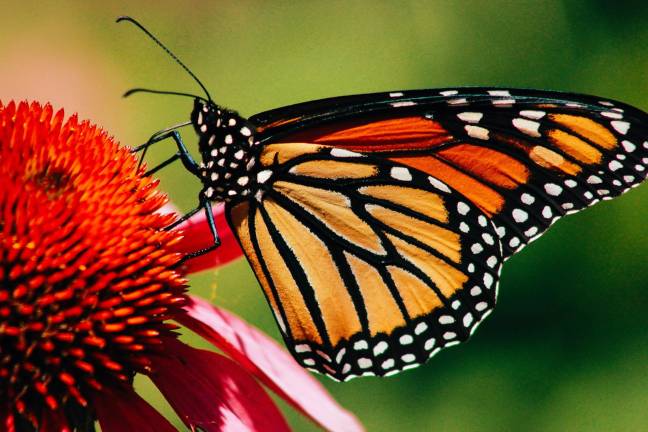Conservation Corner
MONARCH BUTTERFLIES: What you can do to help the survival of these iconic pollinators.

We are sure many of you are familiar with the monarch butterfly and perhaps have noticed their decline in recent years. This iconic butterfly that visits our gardens and flowers each spring and summer is in serious trouble due to loss of habitat and scarcity of the milkweed plant that is critical to the survival of these butterflies.
In addition to being wonderful to have in our gardens they are significant pollinators.
The stages of a Monarch’s life – egg, caterpillar, chrysalis and winged beauty – to many symbolize the hope of renewal and transformation. Monarchs are one of the most recognizable butterflies on Earth. The long-distance feats of monarchs are legendary. In the Summer, eastern monarchs can be found as far north as Canada, and then migrate to the mountains of central Mexico.
And they only weigh as much as a paperclip. How can such a small, frail-looking creature travel so far?
In 2017 there were 200,000 monarchs that gathered in California. In 2020, less than 2,000 were counted, and in New York State they are also in serious decline. The loss of milkweed plants, winter habitat and climate change are all pushing monarchs to the brink.
An endangered species recommendation
Because of this decline throughout the USA the U.S. Fish and Wildlife Service (USFWS) announced in December 2024, its intention to list the monarch butterfly as threatened under the Endangered Species Act (ESA); a move that will have significant implications for land management and development in the future.
This is a much-anticipated step in safeguarding the future of this iconic pollinator. The USFWS routinely identify monarch butterfly populations or predict potential habitat in project sites across the USA, including those for homebuilding and commercial development. The proposed rule does not immediately list the monarch butterfly under the ESA but does start the typically one-year process resulting in a final rule. The final listing from the USFWS is expected in late 2025.
The threatened listing follows years of declining monarch populations, driven by habitat loss, climate change, pesticide/insecticide us, and dwindling nectar and milkweed resources that are necessary for the monarch’s life cycle.
What you can do to help
Homeowners can help the monarchs by planting milkweed and nectar-bearing plants. There are a number of good resources but the US Forest Services is a good start www.fs.usda.gov/wildflowers/pollinators/Monarch_Butterfly/do/index.shtml
If you have any questions or comments about monarch butterflies, or any other conservation issue, please email the Monroe Conservation commission at MCC@monroeny.org or join our Facebook group and leave a comment.
Dennis Fordham is Chair of the Monroe Conservation Commission.